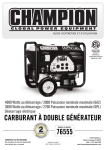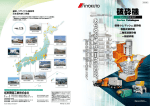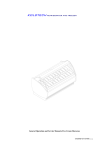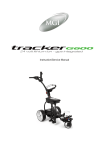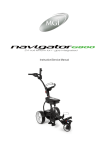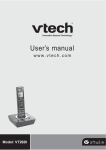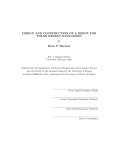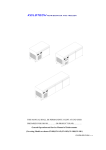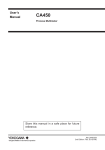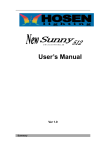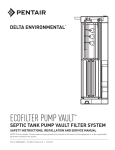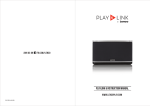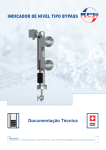Download User Manual
Transcript
R KAP-866 KAP-866 Ëà µÊ ÷ OPERATOR`S MANUAL Autopilot é CONTENTS WARNING 1 FEATURES 2 1 OPER ATION 1.1 Control s 1.2 Turning the power on/off 1.3 Display backlight and contrast adjustment 1.4 Standby Mode 1.5 Auto Mode 1.5.1 Weather Control 1.5.2 Rudder Control (Rudder Ratio) 1.5.3 Counter-Rudder Control 1.6 Follow-Up Mode 1.7 Navigation Mode 3 3 3 4 4 5 5 5 6 6 7 2 M EN U S ET T ING S 2.1 Function Menu 2.1.1 Set Rudder Limit 2.1.2 Set Trim 2.1.3 Stopwatch Timer Alarm 2.1.4 Off Course Alarm 2.2 Installation Menu 2.2.1 Select Remote Unit 2.2.2 Select Rudder Feedback unit 2.2.3 Select Magnetic Sensor Unit 2.2.4 Trim Setting 2.2.5 Auto Heading Adjust 2.2.6 Manual Heading Setting 2.2.7 Heading Alignment Setting 2.2.8 Language Setting 2.2.9 Output Setting 2.2.10 Factory Default Setting 2.2.1 1 Select Type of Steerin g System 10 10 10 11 11 11 13 13 13 14 14 15 16 17 17 18 18 19 CONTENTS 3 AUTOPILOT INSTALLATION 3.1 Installation of Main Unit 3.1.1 Position 3.1.2 Wiring 3.1.3 Magnetic Effect 3.1.4 Power supply consideration 3.2 Installation of Rudder Feedback 3.2.1 Position 3.2.2 Wiring 3.3 Installation of Compass 3.3.1 Installing a Compass-Top Sensor (KCS-20) 3.3.2 Installing an indoor magnetic sensor unit (KFG-25) 3.3.3 Installation an outdoor magnetic sensor unit (KFG-28) 3.4 Installation of solenoil 3.5 Installation of reversing motor pump 3.6 NMEA Connection 3.7 External Alarm Installation 3.8 Installation of Remote Units 3.9 Installation of external rudder indicator 20 20 20 20 20 20 21 21 22 23 23 24 26 27 28 28 29 30 31 4 Commissioning Checks Connection Tests 32 5 MAIN TE NANCE, TROUBLESHOOTING 5.1 Preventive maintenance 5.2 Troubleshooting 33 33 34 6 TECHNICAL PARAMETERS 6.1 General 6.2 Output /Input (IEC61162) 6.3 Environmental Conditions 6.4 Display 6.5 Electrical parameters: 35 35 35 35 35 35 7 INTERCONNECTION DIAGRAM 36 8 DISPLAY UNIT SIZE 38 SAFETY INSTRUCTIONS Safety Instructions for the Operator WARNING Do not open the equipment. Only qualified personnel should work inside the equipment. Do not disassemble or modify the equipment. Fire,electrical shock or serious injury can result. Immediately turn off the power at the switchboard if the equipment is emitting smoke or fire. Continued use of the equipment can cause fire or electrical shock.Contact a ONWA agent for service. Use the proper fuse. Use of a wrong fuse can damage the equipment or cause fire. Safety Instructions for the Installer WARNING Do not open the cover unless totally familiar with electrical circuits and service manual. Improper handling can result in electrical shock. Turn off the power at the switchboard before beginning the installation. Fire or electrical shock can result if the power is left on. Be sure that the power supply is compatible with the voltage rating of the equipment. Connection of an incorrect power supply can cause fire or equipment damage. Use the proper fuse. Use of a wrong fuse can damage the equipment or cause fire. Be sure the power supply is compatible with the equipment. Incorrect power supply may cause the equipment to overheat. The useable temperature range -15 to 55 for the display unit. NOTICE Observe the following compass safe distances to prevent interference to a magnetic compass: Use of the equipment out of those ranges may damage the equipment. Display unit Standard Compass Steering Compass 0.4 m 0.3 m 1.2 m 1.2 m Processor WARNING! Automatic pilots are designed to be a navigational aid. As an automatic steering aid, an autopilot can alleviate the boredom of hand steering. This allows the operator of the vessel time to attend to other duties, keep a more accurate check of navigation duties or just relax and enjoy the trip. HOWEVER, THE AUTOPILOT SHOULD NOT BE LEFT SOLELY IN CHARGE OF THE VESSEL AND AN ADEQUATE WATCH SHOULD BE MAINTAINED AT ALL TIMES. IT IS NOT RECOMMENDED THAT THE AUTOPILOT BE USED WHILE NAVIGATING IN RESTRICTED WATERWAYS AS WATER CURRENTS, WIND CHANGES OR RADIO TRANSMITTER INTERFERENCE MAY AFFCT VESSEL COURSE SUFFICIENTLY TO ENDANGER YOUR OWN OR OTHER VESSELS. 1 FOREWORD Thanks you for purchasing the ONWA KAP-866 Autopilot. The KAP-866 Autopilot controls the vessel steering through mechanical drive, reversing pump set, solenoid valves or relays. The compass must be installed in a place free of magnetic interference, and connected to the autopilot via the cable supplied. The rudder feedback must be attached to the rudder in such a way that it can accurately measure the position of the ship's rudder. This must also be connected to the autopilot via the cable supplied. KAP-866 is designed and constructed to meet the rigorous demands of the marine environment. However, no machine can perform its intended function unless properly installed and maintained. Please carefully read and follow the operation, installation and maintenance procedures set forth in this manual. We would appreciate feedback from you. Thank you for considering and purchasing ONWA. 2 1. OPERATION 1.1 Controls MENU: Press once: Open Activate menu Press 5 sec: Activate installation menu Ship's heading field Control field CTRL: Select controls setting. Mode field R 40 50 60 Heading 70 80 E 100 110 120 M EN U CT RL 080 Weather Rudder Counter 16 10 4 Mode A Set Course 060 KNOB/ENT: Choose menu item. Change course heading. Press the [Enter] 20 Rudder angle field ESC ST-BY AUTO F-UP NAV POWER KAP-866 ARROW KEYS: Press once to change one degree course-to-steer POWER: To switch on/off the unit. To adjust display backlight and contrast Mode Selection ESC: Exit menu and operation. 1.2 Turning the power on/off Power on Press [POWER] once to switch on the unit with a "beep" sound. R KAP-866 Autopilot Ver : 20120101001 3 TURNING OFF IN 3 S EC NOTE: If the device is a long time when not in use,Better to turn off the main switch of the power supply unit. 1.3 Display backlight and contrast adjustment 1. Press the [POWER] key. Dialog box for adjustment of Panel brilliance and display contrast. 40 50 60 Heading 70 80 E 100 110 120 080 Weather Rudder Counter 16 10 4 Mode A 8 Set Course 060 42 20 2. Turn the Knob to select BRILL box and press the Knob to confirm, then turning the Knob to change the backlight brilliance and press the Knob again to confirm the setting. 3. Turn the Knob to select CONTRAST box and press the Knob to confirm, then turning the Knob to change the display contrast and press the Knob again to confirm the setting. 4. Press [ESC] to exit. 40 1.4 Standby Mode 50 60 Heading When switching on the unit it stays on Standby Mode and "Man" display on the Mode field to indicate the steering operate manually. In any steering mode, press [ST-BY] can return to manual steering mode. 70 80 E 100 110 120 080 Weather Rudder Counter 3 10 4 Mode Man Heading 080 3 Command field Mode field Rudder Angle Field 4 1.5 Auto Mode 40 Press [Auto] change steering mode to Auto and "A" display on the Mode field to indicate the steering operate automatic to the set course. 50 60 Heading Weather Rudder Counter 70 80 E 100 110 120 080 16 10 4 Set Course 060 A Mode The autopilot will lock on to the current 20 heading. Change course as follows : a) Rotating the Knob to change the course-to-steer by one degree for each "click". b) Pressing the [ ] or [ ] arrow keys will also cause a one degree course change for each press to corresponding direction. Controls: press the [CTRL] to select corresponding controls, Weather, Rudder and Counter Rudder. Turning the Knob to change the setting of the controls then press the Knob to confirm the setting or press [ESC] to exit. 1.5.1 Weather Control This setting is used for adjusting the autopilot's reponse on varies sea conditions. The weather value sets the desired accuracy of the vesse l steering. A high weather setting will cause the vessel to steer very accurately but may cause excessive use of the steering. In good weather, set this control to a high value, but ensure that the drive arrows display on ship's heading field would not flickering continuously. This will give the straightest possible course. In poor weather, reduce this setting to prevent over-working the steering. 1.5.2 Rudder Control (Rudder Ratio) This setting is used to determine the amount of rudder that the vessel requires for steering (actually, the amount of rudder angle applied for a given angle off course). The centre position is usually suitable for most vessels, but also should depends on the vessel's steering be sensitive or slow, adjustment maybe required. In general, an agile vessel with a relatively large rudder or very small keel will require a small rudder setting. A large, slow vessel may require a high value for the rudder ratio. 5 This may also be adjusted according to speed, low speeds may require more rudder angle for steering than high speeds. A value of 1 signifies the minimum amount of applied rudder (for sensitive steering, large rudders or low gearing ratio. A value of 20 signifies the minimum amount of applied rudder (for vessels with slow steering, small rudders or high gear ratio). When the rudder setting is too low, turns will take an excessive amount of time and the vessel may wander . When the rudder setting is too high, turns will be rapid and the vessel will oversteer. 1.5.3 Counter-Rudder Control In some vessels, changing course requires a large amount of rudder to be applied Initially, and then a smaller amount of rudder in the REVERSE direction to stop the vessel from swinging beyond its desired course. This is called counter-rudder. The KAP-866 Autopilot has this feature built-in. A counter-rudder setting of "1" gives no counter-rudder steering, suitable for light and manouverable vessels. If you find your ship over-steering when under autopilot control, increase the counter-rudder setting by a couple of steps, and see if the next course change behaves better. Once the correct setting is found for your vessel, it should not need to be changed. Unless the loading of your vessel is changed. If you adjust the counter-rudder seting to "A" the counter-rudder functioning automatically apply depends on the rate of vessel turning to the set course. 1.6 Follow-Up Mode Press [FU] to change the steering mode to Follow Up and "FU" display on the Mode field to indicate the rudder steer follows the set command angle on the Command field. 6 Set rudder angle can change the course of the autopilot : a) Rotating the knob will change the rudder angle command by one degree for each "click". 40 50 60 70 Heading Weather Rudder Counter 16 10 4 80 E 100 110 120 080 P20 FU Mode Set Rudder Rudder will steer and stop on the set angle and 20 direction. Rotate the Knob to clockwise direction to drive the rudder to Starboard side while rotate the Knob to Counter-Clockwise direction to drive the rudder to Port side. ] or [ b) Pressing the [ in that direction. ] arrow keys will cause a one rudder angle change 1.7 Navigation Mode For use when KAP-866 is interfaced to a GPS Navigator with NMEA0183 data output. 40 50 60 70 80 E 100 110 120 Heading In Navigation mode this allows the autopilot to be directed by the GPS Navigator, enabling Weather 16 BRG automatic heading changes and eliminating the 10 Rudder effects of wind and tide. Counter 4 The number displays on the Command field Mode Nav indicates the course-to-steer,which will be the 20 bearing between the origin ad destination Waypoints,plus a factor to correct for the Current crosstrack-error(XTE). 080 060 Engaging Navigation Mode Press [ NAV] change the steering mode to Navigation mode and "NAV" display on the Mode field to indicate the steering is directed by the connected GPS Navigator. The vessel will begin turnin from its current course to the course requested by the GPS Navigation. If no GPS data is being received by the KAP-866, the autopilot will lock onto the course of the vessel at the time that Navigation Mode was engaged, and the No GPS Data alarm shall sound. 7 Setting up your GPS Navigator Because there are a great variety of GPS Navigator that will work with this autopilot, the following is a guide only. For more information, Please study your GPS Navigator manual. The GPS Navigator must be set up to output NMEA0183 data on a pair of wires which are connected to the "GPS IN" terminal connections on KAP-866. The data generated must include at least one of the followings: The APA sentence. The APB sentence. The BOD and XTE Sentences. If only the XTE data sentence is available, the pilot can steer in a Restricted manner. See later in this section. The GPS unit must then be commanded to go to a waypoint, or to follow a line joining two or more waypoints (called a route). This unit will then send information to the autopilot from which can be calculated the course-to-steer. IF several waypoints are linked together into a single route, and the GPS unit is set to "auto-sequenence" between them, and an "arrival zone" of more than 0.1 NM(Nautical Miles)is set so that the GPS can detect when the vessel has reached a waypoint, then the KAP-866 will be able to steer from each waypoint to the next without intervention. If only the XTE information is available from your GPS unit then your vessel must be on track, and heading in the correct direction before engaging the GPS mode, and the auto-sequencing feature is not available. 8 Remember: Prior to engaging Navigator mode, a route must be programmed into the GPS for the Autopilot to follow. No GPS Data Alarm If the autopilot is not receiving valid information while in GPS Mode, the No GPS Data alarm will sound, and "NO GPS" will blink on the display. This counld be caused by: Incorrect wiring of the GPS to the KAP-866. Incorrect data output from the GPS unit. No route set up or selected in the GPS unit. No location fix at the GPS unit. The bearings generated by the GPS unit must correspond to the bearings the KAP-866 is receiving from its magnetic compass. The greater the difference between these Bearings, the less accurate will be the Navigator mode steering. Ensure that the GPS unit has the correct magnetic correction factor. Ensure that the KAP-866 compass is correctly aligned and installed. 9 2. MENU SETTINGS 2.1 Function Menu Press [MENU] to display the Function menu. Turning the Knob to move cursor between the Function menu items. Press the Knob to confirm the selection. Turn the Knob to change the setting in the setting in the selected item. Press the Knob to confirm the setting or press [ESC] to exit. FUNCTION MENU SET RUDDER LIMIT : 22 SET TRIM : +00 OFF COURSE ALARM : 00 STOPWATCH TIMER ALARM : 00 2.1.1 Set Rudder Limit There are physical limitations to the angle that the rudder can move through. If the autopilot attempts to drive the rudder past these limits, damage to the steering gear may occur. Setting Rudder Limit is to prevent the rudder from over-steer beyond the set limit. The Rudder Limit will function before the steering system reach the mechanic limit. There are 2 symbols "P_L" (Port Limit) and "S_L" (Starboard limit) will appear on the display. When you see either of these 2 symbols: a) When rudder moves excess the set Port Limit (or Starboard Limit) a "P_L" (or S_L) will appear on the display. No port (or Starboard) rudder movement command will be sent out from the autopilot. b) The functioning of Starboard Limit (S_L) us same as Port Limit (P_L) Note: The factory default setting of Rudder limit is 30 degrees. That means if rudder feedback unit is properly installed then when the rudder is moved over Port or Starboard 30 degrees, the display will show P_L or S_L. 10 2.1.2 Set Trim There are circumstances in which the autopilot may set the rudder in the centre (according to its feedback unit)But the vessel does not steer straight ahead. Reasons for this are: 1. The rudder may not be perfectly aligned. 2. There may be a side-wind, current, net drag, etc, which causes the vessel to steer to one side. KAP-866 can compensate for these errors, but may take a few minutes to core completely. Adjusting the "SET TRIM" can eliminate these Errors immediately. To find the correct trim setting: With the vessel Travelling ahead, switch the autopilot to "Standby" mode. Adjust the trim control until the ship steers straight. The SET TRIM is not intended to be used for adjusting the vessel course in "Auto" or "F-UP" steer mode. 2.1.3 Stopwatch Timer Alarm In any mode press [MENU] to display Function menu. Rotate the Knob to move cursor to "STOPWATCH TIMER ALARM" and press the Knob to confirm. Rotate the Knob to change the setting between 0~180 minutes and press Knob to confirm and save setting. After setting "STOPWATCH TIMER ALARM" the countdown will start once "AUTO" or "NAV" mode is set. when countdown to "0" from preset time the "STOPWATCH TIMER ALARM" will be triggered, a continuously short "beep" sound and flashing "STOPWATCH TIMER ALARM!" will appear on the display. 40 50 60 70 80 E 100 110 120 STOPWATCH TIMER ALARM! Heading 080 Weather Rudder Counter 16 10 4 Mode A 20 11 Set Course 060 The user can press [ESC] to cancel the alarm and the timer will start another countdown again. Once countdown to "0" from the preset time the "STOPWATCH TIMER ALARM" will be triggered again. The "STOPWATCH TIMER ALARM" will be carried out repeatedly until either the user select other modes (ST-BY or F-UP) than "AUTO" or "NAV" modes or change the timer to "000". If the "STOPWATCH TIMER ALARM" is triggered and the user without press [ESC] to cancel the alarm within one minute, the alarm sound will change form short "beep" to continuous long "beep" and the external alarm (if installed) will be triggered. 2.1.4 Off Course Alarm An alarm will sound than a set number of any of which require The angle at which 180 degrees. if the vessel has deviated from its desired course by more degrees. This can be caused by a number of steering faults, attention by the crew. this alarm sounds may be set to any value between 1 and To set the off-course alarm angle In any mode press [MENU] to display Function menu. Rotate the Knob to move cursor to "Off Course Alarm" and press the Knob to confirm. Rotate the Konb to change setting from 0~180 degrees and press the Knob to save setting or press [ESC] to exit without save the setting. When the allowable angle is exceeded, the off-course alarm will sound and a flashing "OFF COURSE" will show on display. When the vessel is brought on to its correct course again, the alarm will cease. Note that the alarm will sound if a large course change is entered. This alarm will cease as soon as the vessel completes its course change. The alarm may also sound when changing from one section of a GPS route to another, and will cancel itself when the course change is completed. The default value for the off-course angle (ie the one set when the KAP-866 is turned on) is 30 degrees. 12 2.2 Installation Menu Press and hold [MENU] button to enter the Installation menu. Rotate the Konb to the desire item and press the knob to enter the that item to make the related change. INSTALLATION MENU SELECT REMOTE UNIT SELECT RUDDER FEEDBACK UNIT SELECT MAGNETIC SENSOR UNIT TRIM SETTING AUTO HEADING ADJUST MANUAL HEADING SETTING HEADING ALIGNMENT SETTING LANGUAGE SETTING 2.2.1 Select Remote Unit There are 2 kinds of option remote units are available from Onwa, Hand Remote (RT580) and Electric Wheel(RW230).Choose either remote unit which is installed. Note: No remote set up is needed if no remite units is installed. INSTALLATION MENU SELECT REMOTE UNIT SELECT REMOTE UNITUNIT SELECT RUDDER FEEDBACK SELECT MAGNETIC SENSOR UNIT 1. HAND REMOTCH TRIM SETTING 2. ELECTRIC WHEEL AUTO HEADING ADJUST [ES C] SETTING ok [EN T] MANUALCancel HEADING HEADING ALIGNMENT SETTING LANGUAGE SETTING 2.2.2 Select Rudder Feedback unit There are 2 kinds of Rudder Feedback units are available from Onwa. heavy duty (KRF35) and light duty (KRF36) rudder feedback unit. Choose the correct rudder feedback unit which is installed. Usually light duty rudder feedback unit is for vessel below length of 50 meters (165 feet) Note: Choice of Rudder Feedback Unit: 1) Heavy Duty Rudder Feedback Unit KRF35-RFUH 2) Light Duty Rudder Feedback Unit KRF-36-RFUS INSTALLATION MENU INSTALLATION MENU SELECT REMOTE UNIT SELECT REMOTE UNIT SELECT RUDDER FEEDBACK UNIT SELECT MAGNETIC SENSOR UNIT TRIM SETTING AUTO HEADING ADJUST RUDDER FEEDBACK UNIT SELECTSELECT RUDDER FEEDBACK UNIT SELECT MAGNETIC SENSOR UNIT 1. RFUH TRIM SETTING 2. RFUS AUTO HEADING ADJUST MANUAL HEADING SETTING [ES C] SETTING ok [EN T] MANUALCancel HEADING HEADING ALIGNMENT SETTING HEADING ALIGNMENT SETTING LANGUAGE SETTING LANGUAGE SETTING 13 2.2.3 Select Magnetic Sensor Unit There are 2 kinds of Magnetic Heading Sensor units are available from Onwa, Fluxgate compass Top Sensor. Note: Choice of Magnetic Sensor Unit 1) Fluxgate Sensor KFG25 and KFG28-FLUXGATE SENSOR 2) Compass Top Sensor KCS20-COMPASS TOP SENSOR INSTALLATION MENU SELECT REMOTE UNIT SELECT MAGNETIC SENSOR UNIT SELECT RUDDER FEEDBACK UNIT SELECT MAGNETIC SENSOR UNIT 1. FLUXGATE SENSOR TRIM SETTING 2. COMPASS TOP SENSOR AUTO HEADING ADJUST [ES C] SETTING ok [EN T] MANUALCancel HEADING HEADING ALIGNMENT SETTING LANGUAGE SETTING 2.2.4 Trim Setting Sometimes for some reasons the installation of Rudder Feedback Unit is not 100% aligned with the position of the Rudder. We could use the Trim Setting to compensate the installation error. Note: It is not advised to use this function to compensate the error if the angle different is excess 5 degrees between actual rudder angle and display angle from rudder feedback unit. Re-installation should be carried out if the said angle error is excessed 5 degrees INSTALLATION MENU SELECT REMOTE UNIT TRIM SETTING SELECT RUDDER FEEDBACK UNIT SELECT MAGNETIC SENSOR UNIT TRIM SETTING +00 AUTO HEADING ADJUST Cancel [ ESC] ok [E NT] MANUAL HEADING SETTING HEADING ALIGNMENT SETTING LANGUAGE SETTING 14 2.2.5 Auto Heading Adjust The compass has been calibrated during manufacture. This calibration will be satisfactory for almost all installations. If you have a steel vessel, or some other factor which causes the compass to perform poorly, the calibration procedure will adjust compass characteristics to compensate. The calibration should only be done if the compass is known to be inaccurate. If the KAP-866 display as constant offset (e.g. The compass reads 3 degrees high on all bearings), simply rotate the Fluxgate Sensor case to align bearings with the ships compass. It is not necessary to re-calibrate the compass as described below. If the KAP-866 has inconsistent variation on different headings, the following calibration procedure can be carried out. This procedure should only be done in calm waters with adequate sea room. In the menu select"AUTO HEADING ADJUST"and press knob The following window appears: INSTALLATION MENU SELECT REMOTE UNIT AUTO HEADING ADJUSTUNIT SELECT RUDDER FEEDBACK SELECTAuto MAGNETIC UNIT headingSENSOR adjusting ! Pleases keep constant speed less TRIM SETTING than 2 minutes for each turn AUTO HEADING ADJUST [ES C] SETTING ok [EN T] MANUALCancel HEADING HEADING ALIGNMENT SETTING LANGUAGE SETTING Press the knob to start auto heading adjustment "Auto heading adjusting" message will appear on the lower part of the display and heading update per second to show the status of adjustment. 40 50 60 70 80 E 100 110 120 080 Weather Rudder Counter Set Course 060 Mode Auto heading adjusting... 15 Steer the vessel in clockwise direction with constant speed less than 2 minutes per each circle until the following correction success message appear. 40 50 60 70 80 E 100 110 120 40 50 080 Weather Rudder Counter Mode 60 70 80 E 100 110 120 080 Weather Rudder Counter Set Course 060 Mode Auto heading adjusting success! Set Course 060 Auto heading adjustment failed! The message goes away after 6 seconds. In case of correction fails repeat the above steps until the correction is successful. 2.2.6 Manual Heading Setting Manual Compensation is a supplement to the type of single orientation parabola to adjacent 10 degrees. This method could be done by qualified personnel. 1) In the Installation menu select "MANUAL HEADING SETTING" and press the Knob, the following window appears: MANUAL HEADING ADJUST 0 30 60 90 +00 +00 +00 +00 +00 +00 +00 +00 120 150 180 210 Cancel [ESC] 240 270 300 330 +00 +00 +00 +00 OK [ENT] 2) Rotate the Knob to choose which bearing you want to correct and press the Knob to confirm. Rotate the Knob to apply compensation and press the Knob to save the change or press [ESC] to exit without save. Note: Anyway ship's magnetic compass and heading on KAP-866 shows each azimuth are unlikely to maintain consistent. 16 2.2.7 Heading Alignment Setting Adjustment of heading might be needed during installation. Usually a fixed error in all direction would exist. It is due to the mechanical error when fixing. 1) Rotate the Knob to select "HEADING ALIGNMENT SETTING" in the installation menu. Press the Knob to show the following window: INSTALLATION MENU SELECT REMOTE UNIT SELECT RUDDER FEEDBACK Heading alignment settingUNIT SELECT MAGNETIC SENSOR UNIT 134 + 00 134 TRIM SETTING AUTO HEADING ADJUST [ ESC] ok [E NT] MANUAL Cancel HEADING SETTING HEADING ALIGNMENT SETTING LANGUAGE SETTING 2) Rotate the Knob to change the heading alignment setting and press the Knob to save the change or press [ESC] to exist the window with out save the change. 2.2.8 Language Setting Choose different languages for different users. 1) Rotate the Knob to select "LANGUAGE SETTING" in the installation menu. Press the Knob to show the following window: INSTALLATION MENU SELECT REMOTE UNIT SELECT RUDDER FEEDBACK LANGUAGE SETTING UNIT SELECT MAGNETIC SENSOR UNIT ENGLISH TRIM SETTING AUTO HEADING ADJUST [ ESC] SETTING ok [E NT] MANUALCancel HEADING HEADING ALIGNMENT SETTING LANGUAGE SETTING 2) Rotate the Knob to select desire language and press the Knob to save change or press [ESC] to exit without save the change. 17 2.2.9 Output Setting INSTALLATION MENU OUTPUT SETTING FACTORY OUTPUT DERAULT SETTING SETTING SELECT TYPE OFSTEERING SYSTEM 1. HDT 2. HDM 3. HDG Cancel [ ESC] ok [E NT] Output data available from KAP-866 includes the following three types: HDT: True heading HDM: Magnetic heading HDG: Magnetic heading & magnetic variation value* Note*: the default magnetic value is 0 since there are no enough data to calculate the magnetic variation. In calculation of magnetic value it requires position data (LON/LAT) and date, those data are not available in KAP-866. Note: Since there are no available data in KAP-866 for calculation of magnetic variation therefore: - "HDT" outputs magnetic bearing instead of ture heading data. - The magnetic variation data in "HDM" would be "0" 2.2.10 Factory Default Setting For any reason need to reset all settings to factory default setting you can do as following instruction. 1. Rotate the knob to select "FACTORY DEFAULT SETTING" in installation menu. Press the Knob to show there following window: INSTALLATION MENU OUTPUT SETTING FACTORY FACTORY DERAULTDEFAULT SETTING SELECT TYPE OFSTEERING SYSTEM R estore to factory default setting ! Cancel [ ESC] ok [E NT] 2. Press the Knob to clear all saved settings or press [ESC] to exist without clear the saved setting. Note: When you select to load factory default setting all saved settings would be cleared. This action can not reversible. 18 2.2.11 Select Type of Steering System Some vessel the steering system is either common positive solenoid or common negative solenoid or reversing motor. KAP-866 can be set to work with above systems. 1. Rotate the Knob to select "SELECT TYPE OF STEERING SYSTEM" in the installation menu. Press the Knob to show the following selection: INSTALLATION MENU OUTPUT SETTING SELECT TYPE OF STEERING SYSTEM FACTORY DERAULT SETTING SELECT TYPE OFSTEERING SYSTEM 1. COMMON POSITIVE SOLENOID 2. COMMON NEGATIVE SOLENOID 3. REVERSING MOTOR Cancel [ES C] ok [EN T] 2. Rotate the Knob to select the correct system and press the Knob to save setting or press [ESC] to exit without save the change. 19 3. AUTOPILOT INSTALLATION 3.1 Installation of Main Unit 3.1.1 Position The KAP-866 main panel should be mounted in an accessible position, Protected from rain or salt water. 3.1.2 Wiring Cablings have to be run from KAP-866 to the rudder feedback unit, compass unit, compass unit and steering drive system. Wiring should be kept as far away as possible from radio aerials and aerial cables to prevent interference to the radio, and to prevent transmitted signals from the radio influencing to the autopilot. The power source for the autopilot should be fused separately from other equipment. Maintain conventional colour coding and, if necessary, mark the cables for ease of identification. Connection - As per diagram labelled Connection Diagram for KAP-866. 3.1.3 Magnetic Effect As a minimum amount of steel is used in the control unit. there is negligible effect on a steering compass. Some radio interference may be caused and the routing of cables should be considered when wiring the vessel. 3.1.4 Power supply consideration KAP-866 can be operated with 12VDC or 24VDC. To consider to use 12VDC or 24VDC you have to find out the operating voltage of steering drive system onboard first. Usually the steering drive system is solenoid drive or reversing motor drive. If the steering drive system onboard is operated on 12VDC the you have to connect 12VDC power suppl to KAP-866. If the steering drive system onboard is operated on 24VDC then you have to connect 24VDC power supply to KAP-866. AUTOPILOT COMPASS REMOTE RUDDER MOTOR ALA/RUDM NMEA I/O POWER IN 12VDC or 24VDC - POWER SUPPLY 20 + 3.2 Installation of Rudder Feedback 3.2.1 Position Install rudder feedback as shown in the diagram labelled Rudder Feedback Unit Installation The unit should be adjacent to the tiller and must copy the angular movement of the tiller. The markings on the rudder feedback unit indicates the required movement of the tiller for course correction. It should be installed with the shaft uppermost, mounted and linked in such a way that the four pivot points (tiller post, feedback shaft and the adjustable linkage points) form the four corners of a parallelogram. The rudder feedback unit is water resistant. However, if it is to be mounted in a wet position, some effort is necessary to ensure the unit does not become immersed in water. If necessary the rudder feedback unit may be mounted upside down, in which case the black and red connections to the KAP-866 ter-minal should be reversed. Optional Connection Arm X Y Y X Rudder feedback unit Rudder 21 3.2.2 Wiring Connect the cable of rudder feedback unit to the 3 pins socket on the rear panel of KAP-866. To check the wirng of the rudder feedback unit by steer the rudder to either side (Port or Starboard), see whether the rudder angle indication on KAP-866 goes to corresponding direction. If the rudder angle indication on KAP-866 goes to reverse direction against the applied rudder then you need to reverse the wiring of RED and BLACK. AUTOPILOT COMPASS Terminal 5V : Terminal Rud : Terminal GND : + 5 volts Signal GND REMOTE RUDDER MOTOR ALA/RUDM NMEA I/O POWER IN Red Yellow Black After installation of the feedback unit is complete and the linkage is fitted, have the steering of the vessel turned lock to lock and ensure: a)The direction (port or starboard) indicated on the top of the RFU is correct. b)No undue mechanical strain is placed on the rudder feedback or linkage. NOTE: THE AUTOPILOT WILL NOT FUNCTION CORRECTLY IF A RUDDER FEEDBACK IS NOT FITTED, OR IF THE FEEDBACK IS FAULTY OR INCORRECTLY ADJUSTED. NOTE: THE RUDDER FEEDBACK UNIT IS FACTORY ALIGNED. THE ARM SHOULD NOT BE REMOVED OR LOOSENED UNNECESSARILY. IF ARM IS LOOSENED OR REMOVED, VOLTAGE ALIGNMENT SHOULD BE CHECKED BEFORE USING THE AUTOPILOT. THIS MUST BE DONE BY A COMPETENT TECHNICIAN. 22 3.3 Installation of Compass There are two types of compass suitable for this autopilot - a magnetic sensor unit (fluxgate), which is a complete compass, and the compass-top sensor (CTS), which is used together with a standard magnetic ships compass. 3.3.1 Installing a Compass-Top Sensor (KCS-20) The sensor unit placed on the glass plate of the ships compass, in the exact centre of the compas card and secured with an adhesive such as double-sided tape or silicon sealant. Before fixing the sensor in place, align it carefully so that the KAP-866 compass displays the same bearing as the ships compass. The compass top sensor is preferred for steel hull vessels provided a suitably compensated compass is fitted to the vessel. Bow Compass sensor Keel line Compass Bow Compass sensor Parallel travel 23 3.3.2 Installing an indoor magnetic sensor unit (KFG-25) The compass unit should be treated carefully as the internal gimbals can be broken if dropped. Remove any internal packing before use. The position of this compass is the most important item in the installation of the autopilot. Good course holding depends on the compass being free from magnetic interference. As this compas s has no moving card, it is not necessary for the compass to be mounted low in the vessel. This is usually a place of high magnetic interference and should be avoided. However, a position of severe roll such as the top of a mast should also be avoided. The compass need not b e mounted in a weatherproof position. The compass can be mounted on top of a flat surface, on a bulkhead or from the deck head. Check other side of bulkhead for materials, which may cause magnetic interference. Interference from any iron or steel can cause malfunction of the compass unit. To prevent this occurring a minimum distance of 1 meter(3 feet) should be kept from any steel or other ferromagnetic materials. This includes speakers and radios with internal speakers. Fasten the compass bracket with non-magnetic screws. The compass must be mounted in a near vertical position. Desktop mounting only suitable for fiberglass or wooden vessel. To ensure the signal of sailing directions is accuracy, please choose a location where vibration and shock are minimal. Installed in the surface of platform 24 Bulkhead mounting Only suitable for fiberglass or wooden vessel. The bulkhead installation can save the space. The bulkhead cannot contain the steel with magnetic interference material. Deck head Top Mount Bracket Fluxgate Sensor Bracket Side Mount Bulkhead Fluxgate Sensor Examples of bulkhead Mount 25 3.3.3 Installation an outdoor magnetic sensor unit (KFG-28) Outdoor installation Keep the length of the cable in mind when selecting a mounting location. It should be far away from their minimum 1 meters to prevent the influence for iron and steel or other magnetic materials. use not magnetic screws for fixed the fluxgate sensor unit. Select the vertical way of positions for installation. Please installed the magnetic sensor unit on the top of wheelhouse. Don't install it in a room so that the magnetic distortion can be minimized. Cable to display unit Fluxgate Sensor Fixed screw Threaded tubes (At least one meter length) Rope Mast Radar antenna Fluxgate Sensor Wheelhouse 26 3.4 Installation of solenoid 3.4.1 Connect common positive solenoids as follow. If the rudder goes to reverse direction against KAP-866 command then you need to reverse the connection of Motor 1 & Motor 2. AUTOPILOT COMPASS REMOTE RUDDER MOTOR ALA/RUDM NMEA I/O POWER IN Motor 1 Port solenoid Motor 2 St'b solenoid Clutch+3 Hand lever (Option) Negative lead of power supply 3.4.2 Connect common negative solenoids as follow. If the rudder goes to reverse direction against KAP-866 command then you need to reverse the connection of Motor 1 & Motor 2. AUTOPILOT COMPASS REMOTE RUDDER MOTOR ALA/RUDM NMEA I/O POWER IN Motor 1 Port solenoid Motor 2 St'b solenoid Clutch+3 Hand lever (Option) Positive lead of power supply 27 3.5 Installation of reversing motor pump Connect reversing motor pump as follow. If the rudder goes to reverse direction agains t KAP-866 command you need to reverse the connection of Motor 1 & Motor 2. AUTOPILOT COMPASS REMOTE RUDDER MOTOR ALA/RUDM NMEA I/O POWER IN Motor 1 Reversing Motor Pump Motor 2 3.6 NMEA Connection KAP-866 can accept extermal heading information in format of NMEA0183 (4800 8n1) to replace standard fluxgate magnetic sensor. KAP-866 can accept either one of the followings NMEA0183 sentence for heading source: 1) HDG 2) HDT 3) HDM When KAP-866 find either one of above NMEA0183 sentence appear on the data in terminal then KAP-866 can priority choose the NMEA0183 sentence as heading source. KAP-866 can also accept GPS information in format of NMEA0183 (4800 8n1) as course setting command. When there is a route or waypoint navigation is engaged in the GPS device, KAP-866 will follow the command from the GPS device to drive the vessel to the waypoint or route which is set in the GPS device. KAP-866 can accept either one of the following NMEA0183 sentence for navigation: 1) APA 2) APB 3) BOD & XTE 28 Data In For GPS navigation or heading information, Connect the data output and data output and data return wires of external device to the IN+ and IN- of KAP-866 GPS connector. Onwa KGN100 or KGN200 is supplied as an option to convert the analog signa l (sychro or stepper) of gyrocompass onboard to NMEA0183 data as heading source to KAP-866. AUTOPILOT COMPASS REMOTE RUDDER MOTOR ALA/RUDM NMEA I/O POWER IN Digital heading source GPS device 3.7 External Alarm Installation An external buzzer may be connected to the ALA + and ALA - of KAP-866 Alarm connector The ALA- output will be 10 volts when the alarm is not sounding (with alarm connected), and approximately 0 volts when active. We recommends a 12-volt piezo buzzer with maximum current draw not exceeding 250 milliamps be connected to this output. If a larger type siren or alarm unit, which draws in excess of 250 milliamps is used, this must be connected via a relay. The KAP-866 external alarm circuit is used to energise the relay coil and power to the siren or alarm unit is connected via the relay contacts. . 29 The external alarm output is activated if the stopwatch timer has been sounding for longer than one minute. AUTOPILOT COMPASS REMOTE RUDDER MOTOR ALA/RUDM NMEA I/O POWER IN External Alarm 3.8 Installation of Remote Units Onw a Hand remote (RT580) and Electric wheel (RW230) is supplied as an option. Sometimes the user require to operate autopilot away from KAP-866 then this time a remote unit is needed. The installation of remote units are very easy, just plug and play. Connect the remote units to the KAP-866 remote connector with the supplied cable. AUTOPILOT COMPASS REMOTE RUDDER MOTOR ALA/RUDM NMEA I/O POWER IN 30 3.9 Installation of external rudder indicator Onwa rudder indicator KRI-80 is supplied an option. Connect KRI-80 to KAP-866 as follow: Canter Range + + KAP-866 Autopilot ALARM 5K control resistor for dimmer control. Center and Range Calibration is needed on the KRI-80 after installation. Place the rudder on midship position, adjust "Center" VR on KRI-80 to get "0" degree on the meter. Place the rudder to 30 degree on either port or starboard, adjust "Range" VR on KRI-80 to get "30" degree on the meter. 31 4. Commissioning Checks Connection Tests Voltage to be connected is the required DC voltage (12 or 24V). Important note: The supply voltage must match the operating voltage of solenoid or reversing motor. Ensure polarity of the voltage supply is correct. All electrical connections are correct. Tie up or cut the unused wires. Turn steering wheel fully clockwise and visually check that moving and mechanical parts do not foul; visually check that RFU has moved in the correct direction as indicated on the RFU label. Note: RFU = Rudder Feedback Unit Dockside Tests Turn steering (by hand) to centre (midships) position. Turn on power supply Determine vessel heading by a sighting on known heading or compass. Align Autopilot magnetic sensor until display reads correct heading. Select AUTO mode on control unit. CAUTION: IF AUTOPILOT DRIVES HARD OVER, IMMEDIATELY TURN CONTROL UNIT OFF, REVERSE MOTOR WIRES MARKED MOT AND MOT AT THE MOTOR CONNECTOR OF KAP-866 AUTOPILOT.. REPEAT FROM STEP 1. Turn course knob 10 degrees to starboard. Confirm that rudder moves to starboard. Turn course knob back to centre, then 10 degrees to port. Confirm that rudder moves to port. Press [ST-BY] key to leave auto mode. NOTE: AT NO TIME SHOULD THE AUTOPILOT DRIVE THE RUDDER INTO THE MECHANICAL STOPS. The autopilot is now ready for full operational testing (sea trials). Testing should Only be carried out in clear waterways until you are familiar with the operation. 32 5. MAINTENANCE, TROUBLESHOOTING 5.1 Preventive maintenance WARNING ELECTRICAL SHOCK HAZARD Do not open the equipment. Only qualified personnel should work inside the equipment. Regular maintenance is important for good performance . A maintenance program should be established and should include the following points. Check connectors and ground terminal on the fluxgate sensor unit and display unit for tightness. Check ground terminal for rust. Clean or replace as necessary. Check for water leakage in the interconnection cable between fluxgate unit and display unit. Clean or replace as necessary. Remove dust and dirt from the display unit and fluxgate sensor unit with a dry, soft cloth. For the LCD, wipe it carefully to prevent scratching, using tissue paper and an LCD cleaner. To remove stubborn dirt, use an LCD cleaner, wiping slowly with tissue paper so as to dissolve the dirt. Change paper frequently so the dirt will not scratch the LCD. Do not use chemical cleaners for cleaning they can remove paint and markings. Note: do not use contain chemical cleaners clean, it might help to eliminate paint and equipment will be marked. 33 5.2 Troubleshooting This section provides basic troubleshooting procedures which the user may follow to restore normal operation. Troubleshooting Symptom Cannot turn on the power Cause Remedy Power cable on the display unit Firmly connect the power cable Power supply failure Check the power supply. Replace fuse with correct rating. Have a qualified technician to check if fuse blown again after replacement. Blown fuse Heading indication changes randomly when ship is at Sensor trouble or anchor or does Cable contact is bad. not change when ship moves. Run the diagnostic test to determine cause. Rudder not functioning Low voltage output 1. Check voltage supply to from KAP-866 or KAP-866 steering system problem 2. Check the steering system No rudder angle indication RFU problem or RFU cable contact is bad 1. Check RFU 2. Check RFU cable 3. Check RFU and rudder connection If large heading error occurs or heading indication is frequently interrupted, contact your dealer for advice. 34 6. TECHNICAL PARAMETERS 6.1 General 6.1.1 6.1.2 6.1.3 6.1.4 Heading Reference: Fluxgate, Magnetic Compass, NMEA Heading Sensor: KFG-25 (standard), KFG-28 & KCS-20 (option) Heading Resolution: 1 Course Detection: 0.1 6.2 Output/Input (IEC61162) 6.2.1 Input: Dual NMEA 0183 inputs Support: APA, APB, BOD & XTE, HDG, HDT, HGM Baud Rate: 4800, n, 8, 1 6.2.2 Output: One NMEA0183 output Support: HDG, HGT, HGM Baud Rate: 4800, n, 8, 1 6.3 Environmental Conditions 6.3.1 Ambient Temperature: -15 ~70 6.3.2 Waterproofing Display Unit: IPX5 Fluxgate Sensor Unit: IPX5 for KFG25, IPX7 for KFG25 Rudder Feedback: IPX7 6.4 Display 6.4.1 Sunlight viewable high contrast LCD 6.4.2 LCD size: 95(W) 63(H)mm, 240 160 dots 6.5 Electrical parameters: 6.5.1 Operating Voltage: 10 to 30VDC 6.5.2 Power Consumption: Standby mode 0.4 Amps, Auto mode 1.0 Amps Peak for control unit only. 6.5.3 Drive Output: 20 Amps max 35 7. INTERCONNECTION DIAGRAM AUTOPILOT COMPASS REMOTE RUDDER MOTOR ALA/RUDM NMEA I/O POWER IN S SOLENOID P POWER SUPPLY MAGNETIC SENSOR RUDDER EXT ALARM NMEA0183 EXT ANGLE IND REMOTE 36 GPS WHEEL SOLENOID OR REVERSING MOTOR 1. MOT+ 2. MOT3. CLU+ 4. CLU- AUTOPILOT COMPASS MAGNETIC SENSOR 1. Green 2. Red 3. Yellow 4. White 5. Blue 6. Shield REMOTE RUDDER MOTOR ALA/RUDM NMEA I/O POWER IN POWER 1. DC input2. DC input+ EXT ALARM&ANGLE IND 1. Alarm+ 2. Alarm3. +5V 4. Rudder Indicator 5. GND RUDDER 1. +5V 2. Sig 3. GND NMEA0183 I/O 1. Input 1+ 2. Input 13. Output + 4. GND 5. Input 2+ 6. Input 27. NC 8. GND REMOTE 1. Adjust 2. Control1 3. Adjust 4. Control2 5. +5V 6. GND 7. +10V 37 8. DISPLAY UNIT SIZE 38













































